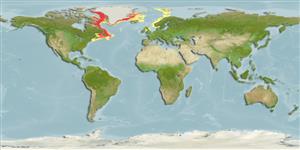Teleostei (teleosts) >
Perciformes/Cottoidei (Sculpins) >
Cottidae (Sculpins)
Etymology: Triglops: Greek, trigla, es = red mullet + greek, ops = appearance (Ref. 45335).
Eponymy: Orvar Nybelin (1892–1982) was a Swedish zoologist, marine biologist and ichthyologist. [...] (Ref. 128868), visit book page.
Environment: milieu / climate zone / depth range / distribution range
Ecology
Marine; demersal; depth range 71 - 1270 m (Ref. 58496), usually 200 - 600 m (Ref. 5951). Polar; 80°N - 41°N, 70°W - 24°E
North Atlantic: found only along the east and west coasts of Greenland and at Jan Mayen and very occasionally in Ungava Bay and on the Labrador coast in Canada.
Size / Weight / Age
Maturity: Lm ? range ? - ? cm
Max length : 20.0 cm NG male/unsexed; (Ref. 7297); 17.0 cm TL (female)
Maximum depth reported at 1270 m (Ref. 58426). Commonly occurs between 200 and 600 m on silty or muddy bottoms at temperatures ranging from -0.1°C to -1.8°C and salinities ranging from 34.8 to 34.9 ppt. (Ref. 7297). Benthic; feeds on crustaceans (Ref. 58426).
Life cycle and mating behavior
Maturity | Reproduction | Spawning | Eggs | Fecundity | Larvae
Pietsch, T.W., 1993. Systematics and distribution of cottid fishes of the genus Triglops Reinhardt (Teleostei: Scorpaeniformes). Zool. J. Linn. Soc. 109:335-393. (Ref. 7297)
IUCN Red List Status (Ref. 130435: Version 2024-1)
Threat to humans
Harmless
Human uses
Fisheries: of no interest
Tools
Can't connect to MySQL database fbquizv2. Errorcode: Too many connections
